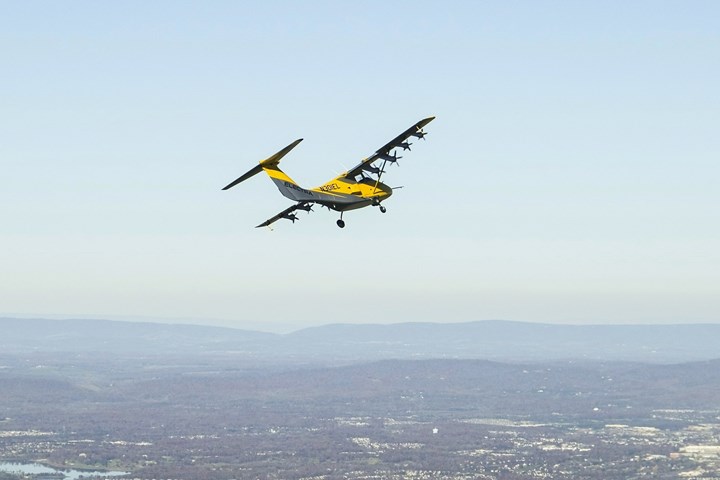Electra completes hybrid-electric eSTOL aircraft flight
The two-seat EL-2 Goldfinch is a blown-lift aircraft filling the gap for air travel routes between 50-500 miles. Certification and entry into service is targeted for 2028.
Electra’s EL-2 Goldfinch soars over the Virginia countryside with a small turbogenerator and batteries powering its eight electric propellers. Photo Credit: JP Stewart/Electra
On Nov. 20, Electra.aero Inc. (Electra, Manassas, Va., U.S.) successfully completed the first flights of its EL-2 Goldfinch, a hybrid-electric, ultrashort takeoff and landing (eSTOL) aircraft.
“The Goldfinch completed an all-electric test flight on Nov. 11 and a hybrid-electric flight on Nov. 19, both piloted by Cody Allee, from the Manassas Regional Airport in Virginia. The first hybrid flight lasted 23 minutes, reached an altitude of 3,200 feet, and covered a distance of approximately 30 miles,” says Electra’s vice president and general manager JP Stewart. “We’re looking forward to further expanding the envelope of this aircraft and demonstrating the full capability of Electra’s technology.”
The two-seat Goldfinch eSTOL technology demonstrator is a blown-lift aircraft using distributed electric propulsion and a hybrid-electric propulsion system. It uses eight electric motors to significantly increase wing lift and enable ultrashort takeoffs and landings while reducing noise and emissions below those of conventional aircraft and helicopters, according to the company. Hybrid-electric power provides long ranges without the need for ground-based charging stations.
Electra is also developing a nine-passenger version of the aircraft for commercial and government markets that can take off and land with ground rolls as short as 150 feet and fly at speeds of 200 miles per hour for distances of 500 miles. Electra’s eSTOL product is backed by strong market interest; the company currently holds pre-orders from more than 30 customers for over 1,700 aircraft, totaling more than $6 billion in backlog. Electra will develop a prototype of a full-scale pre-production eSTOL aircraft under a previously announced strategic funding partnership valued up to $85 million with the U.S. Air Force AFWERX Agility Prime Program. Certification and entry into commercial service under FAA Part 23 regulations is targeted for 2028.
“The aim of Electra is to fill a gap in air travel between 50 and 500 miles, where most trips today are made by automobile,” Electra founder and CEO John Langford adds. “Electra will be able to take you from downtown Manhattan not only to Kennedy Airport, but to Washington D.C. It will bring air service to thousands of communities where air travel today is not a practical or affordable option. It also opens new opportunities for middle-mile cargo logistics.”
Related Content
-
Paris Air Show 2023 highlights
The Paris Air Show, one of the largest aerospace trade shows in the world, returned for the first time since 2019 and proved that the global aviation industry industry is very much alive and kicking.
-
Composites end markets: Aerospace (2023)
With COVID in the past and passengers flying again, commercial aircraft production is ramping up. The aerocomposites supply chain is busy developing new M&P for an approaching next-generation aircraft program.
-
Carbon fiber in pressure vessels for hydrogen
The emerging H2 economy drives tank development for aircraft, ships and gas transport.

















